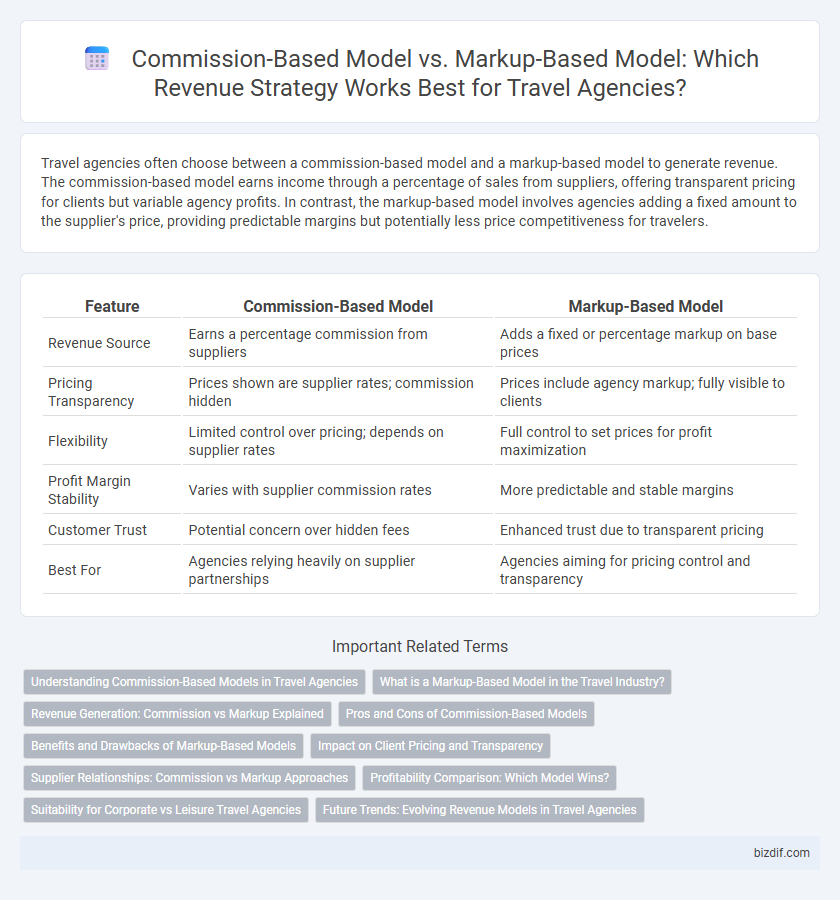Travel agencies often choose between a commission-based model and a markup-based model to generate revenue. The commission-based model earns income through a percentage of sales from suppliers, offering transparent pricing for clients but variable agency profits. In contrast, the markup-based model involves agencies adding a fixed amount to the supplier's price, providing predictable margins but potentially less price competitiveness for travelers.
Table of Comparison
| Feature | Commission-Based Model | Markup-Based Model |
|---|---|---|
| Revenue Source | Earns a percentage commission from suppliers | Adds a fixed or percentage markup on base prices |
| Pricing Transparency | Prices shown are supplier rates; commission hidden | Prices include agency markup; fully visible to clients |
| Flexibility | Limited control over pricing; depends on supplier rates | Full control to set prices for profit maximization |
| Profit Margin Stability | Varies with supplier commission rates | More predictable and stable margins |
| Customer Trust | Potential concern over hidden fees | Enhanced trust due to transparent pricing |
| Best For | Agencies relying heavily on supplier partnerships | Agencies aiming for pricing control and transparency |
Understanding Commission-Based Models in Travel Agencies
Commission-based models in travel agencies involve earning a percentage of the total booking value from suppliers such as hotels, airlines, and tour operators. This model incentivizes agencies to promote specific vendors, aligning their revenue directly with the volume and value of client bookings. Travel agencies leveraging commission-based structures often establish strong supplier relationships to maximize earnings and offer competitive pricing to customers.
What is a Markup-Based Model in the Travel Industry?
A markup-based model in the travel industry involves travel agencies adding a fixed or percentage-based amount to the wholesale price of travel services such as flights, hotels, or tour packages. This model enables agencies to earn revenue transparently by clearly defining the final sale price to customers, distinct from the original supplier cost. It contrasts with the commission-based model where agencies earn a percentage of the supplier's price without altering the base cost seen by the customer.
Revenue Generation: Commission vs Markup Explained
In the commission-based model, travel agencies earn a percentage of the total booking value directly from suppliers, generating revenue through negotiated commission rates on flights, hotels, and tours. The markup-based model involves adding a fixed profit margin to the wholesale price, allowing agencies to control final pricing and potentially increase revenue per transaction. Understanding the nuances between commission earnings and markup strategies is crucial for optimizing revenue generation and maintaining competitive pricing in the travel industry.
Pros and Cons of Commission-Based Models
Commission-based models in travel agencies offer the advantage of aligning agent incentives with sales volume, encouraging higher booking rates and fostering stronger supplier relationships. However, reliance on supplier commissions can limit profit margins and create vulnerability to fluctuating commission rates or policy changes. This model may also reduce transparency for customers, potentially impacting trust and satisfaction.
Benefits and Drawbacks of Markup-Based Models
Markup-based models in travel agencies offer transparent pricing by adding a fixed percentage or amount to the base cost, allowing clients to see the price breakdown clearly. This model benefits agencies by providing consistent profit margins regardless of supplier fluctuations, but it may lead to higher prices for customers compared to commission-based models. However, the drawback includes potential customer perception of inflated costs and reduced flexibility in negotiating with suppliers to pass on savings.
Impact on Client Pricing and Transparency
In the commission-based model, travel agencies receive a percentage from suppliers, often resulting in less transparent pricing since clients see supplier rates without clear agency fees. The markup-based model adds a distinct fee to the base price, enhancing transparency by showing clients the exact agency charge and enabling better price comparisons. Transparent pricing in the markup model fosters trust and empowers clients to understand the cost breakdown of their travel bookings.
Supplier Relationships: Commission vs Markup Approaches
Commission-based models strengthen supplier relationships by providing travel agencies with a percentage of the supplier's sale, aligning their incentives for mutual growth and encouraging consistent collaboration. Markup-based models give agencies control over pricing by adding a fixed or variable fee on top of supplier costs, which may risk transparency but allow flexibility in profit margins. Understanding these distinct approaches helps travel agencies optimize supplier partnerships and maximize revenue through tailored commission or markup strategies.
Profitability Comparison: Which Model Wins?
The commission-based model offers steady revenue by earning a percentage of supplier sales, ensuring consistent profitability with lower risk. In contrast, the markup-based model allows travel agencies to set prices above cost, potentially increasing profit margins but requiring careful market analysis to avoid pricing out customers. Profitability ultimately depends on the agency's ability to balance competitive pricing with supplier relationships, but commission-based models generally provide more predictable income streams.
Suitability for Corporate vs Leisure Travel Agencies
Corporate travel agencies often prefer the commission-based model due to its transparency and alignment with negotiated supplier rates, facilitating streamlined expense management and compliance. Leisure travel agencies typically favor the markup-based model, allowing greater flexibility to adjust prices for retail clients and enhance profit margins on customized vacation packages. Understanding these distinctions helps travel agencies tailor their pricing strategy to better serve their specific market segments and optimize revenue.
Future Trends: Evolving Revenue Models in Travel Agencies
Future trends in travel agencies highlight a shift from traditional commission-based models, where agencies earn a fixed percentage from suppliers, to more dynamic markup-based models that allow for personalized pricing and enhanced profit margins. Advanced data analytics and AI-driven tools enable agencies to tailor markups based on customer preferences, demand patterns, and competitive landscapes, optimizing revenue streams. Integration of blockchain technology promises greater transparency and efficiency in revenue models, fostering trust between agencies, suppliers, and travelers.
Commission-based model vs Markup-based model Infographic

 bizdif.com
bizdif.com